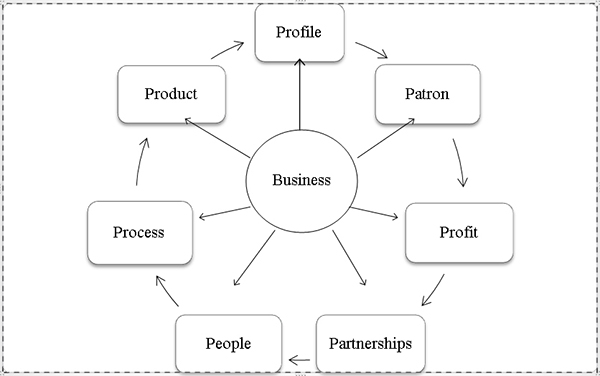All the Ps are closely interlinked to each other and while addressing the issues of any one P, the contribution by and the impact on the other Ps will invariably come up during the discussions.
A diagrammatical representation of the 7 Ps of business is given below.
 Status Evaluation
Status Evaluation
Early in the coaching journey, evaluation of the current status of each one of the Ps is carried out, in qualitative and quantitative terms, and using a scaling, where appropriate, with reference to the long term goals.
Exploration
This is the stage of exploration and analysis – of current situation, the environment, the industry, competitive activity and the market, bench-marking, the strengths and weaknesses of the business, the opportunities and threats, industry trends, the practical difficulties and bottlenecks to overcome, the risks associated with the business, etc. This will also entail review of the competitive strategy pursued, its effectiveness and any changes considered necessary. The analysis and exploration will lead to greater awareness of the opportunities and the risks involved, the alternatives available and challenging status quo with likely revision of goals for some or all of the P elements.
SWOTT
An important part of the exploration stage is the SWOTT analysis, the acronym standing for Strengths, Weaknesses, Opportunities, Threats and Trends. While strengths and weaknesses are internal factors, opportunities and threats are external.
Strengths of the business are those core capabilities with unique advantages over competition, while Weaknesses are those core capabilities where the competitors have advantages. Opportunities are those external factors which open up new possibilities for the business and Threats are those which adversely affect growth and profitability of the business. Analyzing the Trends in the industry will reveal potential opportunities as well as risks and thus provide useful insights into the business and its environment.
Goals
Goal setting is done in two stages. In the initial stage, post evaluation of the current position across all the P elements, goals are set for each P, in line with where the business needs to move forward. The goals will be thus in alignment with the vision, mission, values, ethics and long term objectives of the business. There will be interim milestones specified for each P at various stages of progress. Goals can also be set for the short term only, when such is the coaching objective, and these will also have to be in line with the long term.
In the second stage, once the detailed exploration of the business situation has been carried out and new insights achieved, and perhaps the goals set in the first stage have been challenged and enhanced as appropriate, there may be need to take a fresh look at the goals and amend them as necessary and include some new goals as well.
These goals will all be SMART goals which are specific, measureable, achievable, relevant and with time bound targets.
Action plan
At this stage, the alternative routes to achieve the goals are assessed and choices made about the action steps. The various steps required to reach the desired goals for each of the Ps are agreed upon. The action steps are then grouped and allocated by responsibility centres, say, by departments and business units, to enable proper accountability.
Measurement & Review
For each of the SMART goals, the success criteria are agreed upon and the measures, along with the method and frequency of measurement, are determined. The measures are grouped into two categories – the lead measures and the lag measures. Lead measures are those indicators that monitor tasks, activities, processes which have been designed to deliver the relevant goal. These can be measured real time on an hourly, daily, weekly, monthly basis. On the other hand, lag measures are indicators of the final outcome or goal and can be measured periodically, only well after the event and therefore not very useful in day to day operations management. For regular monitoring of accountability the lead measures are very useful, while the lag measures are required primarily for monitoring the final outcome only.
Depending on the progress achieved, challenges faced and changes in circumstances, there may be a need for periodic review of the action plans and this, in turn, may necessitate a revisit of the entire cycle of exploration, goal revision, new action as well as new set of measures.
Vision, Mission, Values & ethics
The entire exercise of establishing goals and designing actions will be done in alignment with the vision and mission and long term objectives of the business. The processes and actions to be followed will align themselves with the set of values and ethical standards of the business as established by the entrepreneur.
Coaching sessions
The coaching model described above will be applicable for the entire coaching journey as well as to the individual coaching sessions. In the individual sessions, a part of the process can be covered for all the Ps or the entire process for a single P or even a part of the process for a single P, depending on the needs of the coachee.
Application to executive coaching
The model applies to executive coaching too. In such a case, depending on the needs of the executive, the focus can move from business improvement to improvement in personal effectiveness of the executive as a leader. The discussion can again move back to business improvement once leadership aspects have been dealt with. The exploration in leadership effectiveness may lead to change in mindsets, reframing and removal of mental barriers if existing. The switching back and forth in focus – from business aspects to leadership aspects – can be freely done within the model, depending on the needs and desires of the client and of the situation.